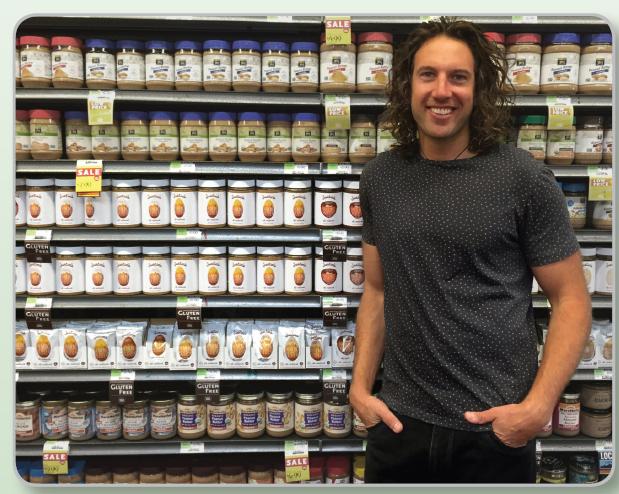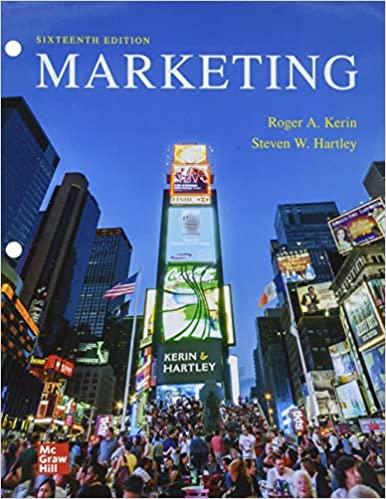If you dont start somewhere, youll never end up anywhere, explains Justin Gold, entrepreneur and founder of
Question:
“If you don’t start somewhere, you’ll never end up anywhere,”
explains Justin Gold, entrepreneur and founder of the Justin’s brand of organic nut butters and peanut butter cups. It was this mantra that helped Gold turn his passion for good-tasting organic food into his now-famous brand and a growing portfolio of successful products. In fact, the Justin’s website proclaims that Justin’s is “Making a Butter World!”
THE COMPANY:
The idea for better nut butter came from Gold’s personal experiences. “I’m an active vegetarian and I was mountain biking, running, and skiing,” he explains.

The combination meant that nut butter was a staple in his diet. “I was curious,” he adds, “Why is it that peanut butter is only available in two flavors—smooth and crunchy? Why can’t you flavor a peanut butter?”
So, Gold bought a basic food processor and natural ingredients and began experimenting at home in his kitchen. He filled jars with his new flavors, and to deter his roommates from eating them he labeled the jars “Justin’s.” That simple decision was the beginning of the brand name for his products and for the company!
Everyone who tried the homemade nut butters encouraged Gold to start selling them. As a result he created a business plan based on research about consumers and advice from a network of mentors. According to Gold, “As an entrepreneur you basically think about things in four sections—sales, marketing, operations, and finance.” The first sales of the product were through a farmer’s market, and popularity there led to distribution in select retailers, including Whole Foods. The big breakthrough, however, came when Gold decided to package nut butter in a squeeze pack. The packages were placed next to the jars on the shelf in the stores, and consumers would buy them as a trial size and then come back and buy a jar.
“That squeeze pack really put us on the map as an innovator in the nut butter category,” says Gold. “It set us apart from all the competitors out there because we had a point of differentiation.”
Justin’s continued to grow and was ranked in the Top 15 on the Inc.
Fastest Growing Companies list for the Food and Beverage category. In addition, Gold was recognized as Entrepreneur of the Year by Ernst & Young. Three key values have contributed to the company’s success. They include:
• Passion for natural and organic foods.
• Consciousness of sustainable and environmentally friendly practices and concern for the community.
• Product quality based on production innovation, nutrition, and amazing taste.
Eventually Gold decided that he needed a partner to continue the company’s growth. Justin’s was sold to Hormel Foods Corporation, a multinational manufacturer and marketer of consumer-branded food products, including Skippy peanut butter. “We felt that they were the perfect partner for us: we felt that Hormel was buying into our values and our mission,” says Gold.
Today Justin’s product line includes 10 flavors of nut butters, eight variations of nut butter cups, four types of snack packs, and a cookbook titled Justin My Kitchen. In addition to the initial distribution through Whole Foods stores, retail partners now include Safeway, Costco, Target, REI, Natural Grocers, King Soopers, Sprouts, and Walmart. Online retailers also include Amazon.com, Jet.com, and Thrivemarket.com. Sales have grown to include millions of jars and squeeze packs of nut butter!
Recently, Justin’s received a Most Innovative New Product Award from the National Confectioners Association for its new Organic White Chocolate Mini Peanut Butter Cups.
PRODUCT AND BRAND MANAGEMENT AT HORMEL:
Hormel’s acquisition of Justin’s provided the growing nut butter company with a variety of resources. First, the acquisition provided Justin’s with access to national distribution channels in the food industry. Second, it provided access to a wide variety of suppliers to ensure that many of the ingredients of Justin’s existing and future products could be organic. Finally, Hormel provided sophisticated brand management expertise.
Lisa Selk, CEO of another Hormel acquisition, CytoSport, and the previous marketing director of Skippy brand peanut butter, describes the brand management orientation. “Hormel is a $9 billion company. We have a long legacy of developing brands and creating great products for American consumers and across the globe. We have 35 number one or two brands and over 20,000 employees in our company. We have passion around all of our brands,” she says. The company has developed an organizational brand structure that utilizes a variety of management tools to ensure the success of the brands.
The product life cycle, for example, provides guidance for many of Hormel’s brand managers as some products have a long history with the 120-year-old company while other products are much newer to the marketplace. “If you think about the product life cycle of Skippy, it’s definitely a mature product and brand,”
explains Selk. “The typical marketing strategy for a mature brand is mass media reminder messages. It is really about how many impressions you can get across TV, print, social, and digital spaces.” Product managers can guide their brands through the product life cycle by modifying the product, modifying the market, and repositioning the product. Skippy, for example, is using these approaches by creating PB Bites, finding new consumers through online channels, and positioning the product as a source of protein.
Hormel also uses a combination of branding strategies.
A multiproduct branding strategy, using one name for many products, is applied to products such as Hormel Bacon, Hormel Chili, Hormel Deli Meats, and Hormel Pepperoni. A multibranding strategy, using a distinct name for each product, is also used by Hormel for many of its brands such as Jennie-O, Muscle Milk, Skippy, and Justin’s. The combination of products and brands creates a portfolio that must be managed.
Another important brand management tool is package design and labeling. “Design is extremely important in the early development of a product,” explains Selk, “because you cannot change during its life cycle.” The package design helps consumers identify the product and they become accustomed to searching for the familiar appearance on the shelf. Occasionally small changes are warranted, however. According to Selk, “Benefits are going to change.” For example, “Protein is one of those things that consumers are looking for in their daily diet so we’re calling out how many grams of protein on the front of the package,” she continues. The label also provides essential information, particularly as regulations about nutritional facts change.
MARKETING AT JUSTIN’S:
There are many traditional and unique aspects to the marketing organization at Justin’s. “Marketing at Justin’s is organized on two paths,” explains Mike Guanella, president of Justin’s. “We have the brand managers who own all elements of the product line, all the four Ps, and we have master brand managers who own all of the communications that touch on all elements of the brand, not just the products.” The brand

managers serve in a traditional role by assuming responsibility for developing and executing the specific elements of the marketing program, while the master brand managers provide a creative solution to communication activities that influence the entire brand name.
Justin’s brand managers are typically responsible for a category such as nut butters or butter cups. “The brand manager owns a specific product line, either spreads or confection, and they would own all elements of that brand, the decision making around strategy, and tactics,” says Guanella. “Think about the brand manager being the hub of all the spokes that come out to deliver a product to the market. Our brand managers own every element of the four Ps from our promotional strategy, to everyday pricing, to working with our sales team.” The master brand managers must take a broader perspective. According to Guanella, “Our master brand managers own elements that cut across all our product lines.” For example, “Our website and our media campaigns focus on Justin’s as a master brand as opposed to specific product lines.”
The brand managers and master brand managers work together on new and existing products. New products are developed and typically launched in the natural food retailer channel with samples, demos, and event marketing. As the products grow, their distribution is expanded to conventional retailer channels with traditional promotion. Finally, “some of our products are approaching the mature phase,” says Guanella, which becomes “an opportunity to refresh those products with different flavor offerings or different size offerings.”
THE FUTURE:
The team at Justin’s is very excited about the future. Selk observes that “as a marketer the best feeling you can have been to create a product and put it on the shelf and watch it be consumed by people.” Guanella comments, “I work for a company that makes products that I love and does it in a meaningful way. A company that’s focused on sustainability and corporate responsibility.
It’s the perfect combination. I love what I do!” And as Gold himself discloses, “at Justin’s, we call it the Nuthouse because you want to go somewhere where you’re not only working but you love to come to work, and you feel like you’re making a difference!”37
Questions
1. How are passion, consciousness, and product quality part of the product management process at Justin’s?
2. How does the stage of the product life cycle influence marketing decisions at Hormel and Justin’s?
3. What roles are served by the brand managers and master brand managers of Justin’s products and brands?
4. Describe the branding strategies used by Hormel and how Justin’s products fit into the Hormel product line.
5. How are sustainability and corporate responsibility considerations likely to influence the future at Justin’s?
Step by Step Answer:






